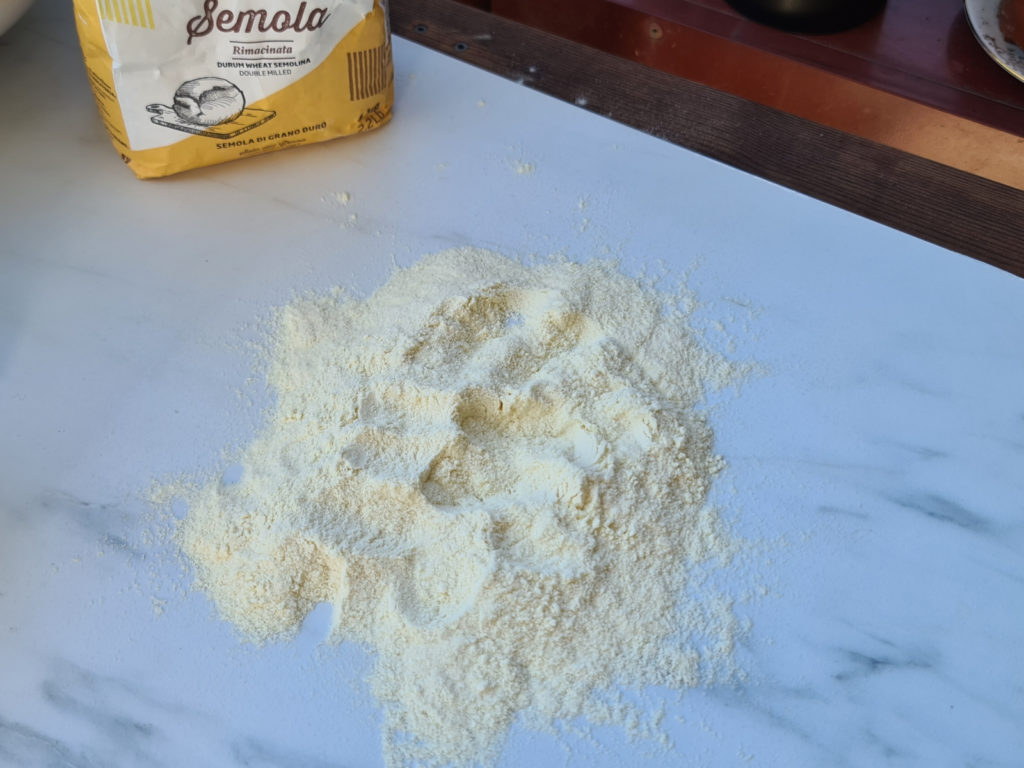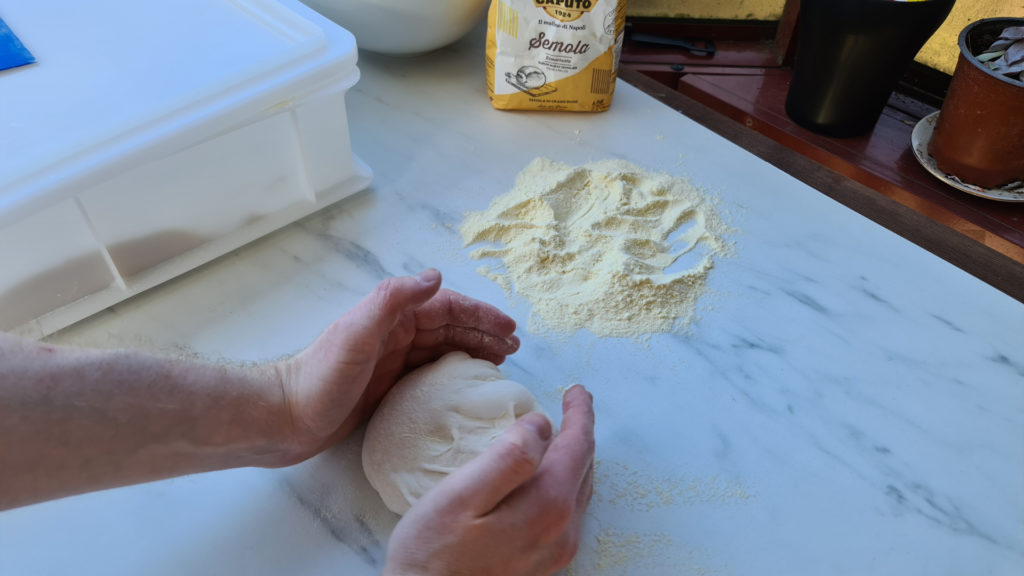Have you ever struggled with pizza dough sticking to the peel? It’s a frustrating but common issue in pizza making. The solution? Semolina.
When exploring the art of pizza in Naples, I noticed many pizzerias used semolina on their peels. This isn’t your ordinary flour. Semolina’s slightly coarser texture acts as a barrier, preventing the dough from sticking. It’s a simple, yet effective choice that combines tradition and practicality.
Now, if you’re looking for the best semolina, I have a recommendation. Caputo Semola is a favorite in Naples, and for good reason. Its ideal grain size and heat resistance make it perfect for pizza making. With Caputo Semola, your dough won’t just easily slide off the peel; it’ll also bake beautifully.
Semolina 101: Why Semolina Is the Pizza Maker’s Choice
When it comes to crafting the perfect pizza, the type of flour you use matters more than you might think. Semolina is a key player in the pizza-making game.
- Non-stick: Semolina’s coarse texture means less sticking and smoother pizza transfers.
- Heat resilient: It can handle the high heat of pizza ovens without burning.
- Versatile use: Great for Neapolitan and other pizza styles too.
Semolina, derived from durum wheat, has a slightly rough texture, making it a standout choice for pizza peels. Its larger, coarser grains create a natural non-stick layer, ensuring your dough glides effortlessly into the oven. This is a game-changer, especially when compared to finer flours like all-purpose or bread flour, which can stick and burn in high heat.
During my time in Naples, the birthplace of pizza, I saw firsthand how semolina is the go-to choice in many of the top pizzerias. Semolina can withstand high heat, and this is crucial when baking pizza in a blazing hot wood-fired oven. Other types of flour can burn in the oven and add bad flavors to your pizza.
Semolina isn’t just limited to Neapolitan pizza. It’s going to benefit any type of pizza that you need to slide on and off a
Using Semolina on Your Pizza Peel
Getting your pizza smoothly off the peel and into the oven can feel like an art form. The key is using semolina correctly. Here’s how to get it every time.
- Use the right amount: Open and stretch the dough using plenty of semolina to ensure the dough is not sticky. Then shake off the excess semolina.
- Even spreading: Spread an even layer across the peel. You can use a shaker or simply your hand.
- Non-stick check: Before placing the dough, give the peel a gentle shake. If it slides easily, you’re all set.
Now, let’s dive deeper into these tips. The amount of semolina is crucial, too much can cause burning and affect the taste, while too little might result in the dough sticking to the peel. The right way to do it is by opening and stretching the dough in plenty of semolina flour to ensure there are no sticky spots. Then shake off the excess flour before moving the dough to the peel. This way you’ll make sure the dough will not stick, and you’re not using too much semolina that will burn in the oven.

When it comes to spreading, the goal is an even cover of the entire surface of your peel. A tiny sprinkle is enough since you already got rid of the sticky spots when preparing the dough. This extra sprinkle will ensure you create the perfect barrier between the dough and the peel, which will make launching the pizza into the oven a breeze.
After spreading semolina and placing your dough on the peel, perform a quick shake test. This simple move ensures your dough is ready to slide into the oven without any hassle.
As mentioned, it’s important to shake off any excess semolina. Not only does this prevent waste, but it also avoids any unwanted burnt flavor in your pizza. Here’s where a perforated peel can be incredibly useful, making it easy to get rid of extra semolina. A perforated peel also has a smaller surface area to stick to for your dough, due to the small holes all across the peel.
This lightweight premium, anodized aluminum peel features a balanced 12x14-inch blade for effortless handling and a perforated surface to reduce sticking.
Through my own experiences and observations in Naples, I’ve learned the importance of striking the right balance with semolina. It’s a simple yet effective trick that can elevate your pizza-making game to the next level.
Selecting the Right Semolina
In your quest to make the perfect pizza, the type of semolina you choose plays an important role. Not every semolina is the same.
The world of semolina is more diverse than you might think. The main difference lies in the grain size. Ranging from fine to coarse. For pizza peels, medium coarseness grains are usually the way to go. This durum wheat semolina doesn’t just help your pizza slide off the peel effortlessly, it’s also easier to get rid of excess semolina to avoid burning.
Through my own trials and countless pizzas, I’ve experimented with various types of semolina. Each has its unique properties, but time and again, I’ve found that the medium coarseness variety delivers the best results. It’s easiest to slide the pizza off the peel, and they also handle the heat better.
When shopping for semolina, keep an eye out for labels that specify ‘coarse’ or ‘durum wheat’. Quality matters, and investing in good semolina can make a noticeable difference. [Here’s a brand I personally recommend] (affiliate link), known for its consistent quality and perfect grain size for pizza making.
Remember, the right semolina can be the secret touch that transforms your homemade pizza into a culinary masterpiece. It’s a small detail, but in the world of pizza making, every detail counts.
The Best Semolina to use with your pizza peel
When it comes to making pizza at home, the choice of semolina can have a big impact on your result. After much experimentation, experience, and advice from top pizzaiolos, I’ve found the best semolina for
Why Caputo Semola stands out:
- Optimal grain size: Caputo Semola has the perfect coarseness for pizza peels, ensuring your dough slides off seamlessly into the oven.
- Consistent quality: In all my years of pizza making, Caputo has never let me down. Its consistent quality guarantees the same great results in every bake.
- Heat resistant: This semolina can withstand the high temperatures of home ovens and even wood-fired ovens, preventing the burning that finer flours are prone to.
But it’s not just my personal preference. In Naples, the heartland of pizza, Caputo Semola is a common sight in many top pizzerias. This widespread use isn’t just about tradition; it’s a testament to its reliability and the authentic taste it brings to pizza.
If you’re serious about your pizza making, give Caputo Semola a try. The difference it makes might just surprise you.
Common Semolina Challenges in Pizza Making
Mastering the use of semolina can elevate your pizza-making game, but it comes with its own set of challenges. Let’s tackle this head-on.
Ensuring Enough Semolina When Opening Dough
A common mistake is not using enough semolina when you open the dough. To avoid a sticky mess, generously coat your dough and work surface with semolina. This step is crucial for creating a non-stick foundation. However, once you’ve got your dough shaped, remove as much excess semolina as possible. This balance ensures your pizza slides off the peel effortlessly without leaving a gritty residue.
Using the right peel is also crucial to help get rid of excess flour. Check out our pizza peel guide to make sure you find the right peel.
Managing Semolina Burn
Semolina can burn on a pizza stone or a hot pizza, affecting the taste of your pizza. To prevent this, the key is to shake off as much excess semolina as possible before baking to reduce the risk of burning.
Balancing Semolina with Other Flours
While you might come across recipes suggesting a mix of semolina with other pizza flours, I recommend sticking mainly to semolina for its heat tolerance and texture. If you decide to experiment, choose flours that can withstand high heat, particularly if you’re making Neapolitan pizza in a wood-fired oven.
Storage and Shelf Life
Proper storage of semolina is important for maintaining its quality. Keep it in an airtight container in a cool, dry place. As for its shelf life, semolina doesn’t spoil quickly, but if it starts to smell off or changes color, it’s time to replace it.
Frequently Asked Questions About Using Semolina in Pizza Making
What is Best to Use on a Pizza Peel to Prevent Sticking?
Semolina flour is the best option to prevent pizza dough from sticking to a
Do You Use Fine or Coarse Semolina for Pizza?
A semolina with medium coarseness is the best choice for pizza, especially when using a
How Much Semolina Should I Use to Avoid Sticking but Prevent Burning?
A light, even layer of semolina on your peel is usually sufficient to prevent sticking. About a tablespoon for a medium-sized pizza is a good starting point. Be sure to shake off any excess to prevent burning.
Can Semolina Be Used with Any Pizza Dough?
Yes, semolina works well with various types of pizza dough, from classic Neapolitan to hearty New York-style. Its versatility and non-stick properties make it a universal choice for different pizza-making styles.
Can I Use Semolina for Gluten-Free Pizzas?
Semolina is made from durum wheat, so it contains gluten. For gluten-free pizzas, you’ll need to find gluten-free alternatives like rice flour.
Is It Necessary to Adjust Oven Settings When Using Semolina?
No specific adjustments to oven settings are needed when using semolina.
Wrapping Up: Your Path to Pizza Perfection with Semolina
As we end our journey exploring the wonders of semolina in pizza making, let’s quickly revisit what we’ve learned. The right type of semolina – medium coarseness and heat-resilient – can significantly elevate your pizza-making game. It’s the secret ingredient that ensures your pizza slides effortlessly off the peel and into the oven, resulting in a delicious, crispy crust.
The role of semolina in pizza making goes beyond just preventing sticking, it’s a tradition that has been refined over generations. Its coarser grains and heat tolerance are not just a matter of convenience but a pathway to achieving that authentic, pizzeria-quality pizza at home.
I encourage you to experiment with semolina in your next pizza endeavor. Whether you’re a seasoned pizza maker or just starting out, the practical tips and insights shared here can help you master the art of pizza making. Remember, great pizza is a blend of science, art, and a bit of personal flair.

- Is Your Pizza Dough Too Dry? Here is How to fix it! - June 10, 2024
- The Ultimate Guide to the Pizza Dough Windowpane Test - June 8, 2024
- The Ultimate Guide to Autolyse Pizza Dough - June 7, 2024

